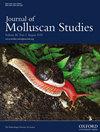Substrate specificity of phenoloxidase-like activity in an ecoimmunological model species Lymnaea stagnalis
IF 1.2
4区 生物学
Q2 MARINE & FRESHWATER BIOLOGY
引用次数: 0
Abstract
Ecoimmunological research on molluscs and other invertebrates frequently quantifies phenoloxidase (PO) activity to estimate the strength of the immune function. PO enzymes form different families whose relative roles in oxidative reactions are typically unknown. Understanding this could allow enzyme-specific assays with higher accuracy than in commonly used nonspecific assays. We tested the contribution of different PO enzyme families to haemolymph PO-like activity in Lymnaea stagnalis snails using substrates specific to enzymes detected in L. stagnalis transcriptome data (p-phenylenediamine, specific to laccases; L-tyrosine, specific to tyrosinases) and compared the reactions to those with a nonspecific substrate (L-dopa). We found laccase-like but no tyrosinase-like activity. However, reactions with L-dopa were the strongest, possibly due to other oxidative enzymes in snail haemolymph. Laccase-like activity is common in molluscs, and we propose the use of enzyme-specific assays in future ecoimmunological studies of this taxon. The lack of tyrosinase-like activity in L. stagnalis contradicts earlier transcriptome data, which calls for investigating the expression of PO enzymes in L. stagnalis at the proteome level.一个生态免疫模式物种鹿柳酚氧化酶样活性的底物特异性
对软体动物和其他无脊椎动物的生态免疫学研究经常量化酚氧化酶(PO)活性,以评估免疫功能的强度。PO酶形成不同的家族,其在氧化反应中的相对作用通常是未知的。了解这一点可以使酶特异性测定比常用的非特异性测定具有更高的准确性。我们使用在鹿尾螺转录组数据中检测到的酶特异性底物(对苯二胺,漆酶特异性;L-酪氨酸,酪氨酸酶特异性),测试了不同PO酶家族对鹿尾螺血淋巴PO样活性的贡献,并将反应与非特异性底物(L-多巴)的反应进行了比较。我们发现了类似漆酶但没有类似酪氨酸酶的活性。然而,与左旋多巴的反应最强,可能是由于蜗牛血淋巴中的其他氧化酶。漆酶样活性在软体动物中很常见,我们建议在未来对该分类单元的生态免疫学研究中使用酶特异性测定。牡鹿中缺乏酪氨酸酶样活性与早期的转录组数据相矛盾,后者要求在蛋白质组水平上研究PO酶在牡鹿中的表达。
本文章由计算机程序翻译,如有差异,请以英文原文为准。
求助全文
约1分钟内获得全文
求助全文
来源期刊

Journal of Molluscan Studies
生物-动物学
CiteScore
3.00
自引率
8.30%
发文量
36
审稿时长
3 months
期刊介绍:
The Journal of Molluscan Studies accepts papers on all aspects of the study of molluscs. These include systematics, molecular genetics, palaeontology, ecology, evolution, and physiology. Where the topic is in a specialized field (e.g. parasitology, neurobiology, biochemistry, molecular biology), submissions will still be accepted as long as the mollusc is the principal focus of the study, and not incidental or simply a convenient experimental animal. Papers with a focus on fisheries biology, aquaculture, and control of molluscan pests will be accepted only if they include significant advances in molluscan biology. While systematic papers are encouraged, descriptions of single new taxa will only be considered if they include some ‘added value’, for example in the form of new information on anatomy or distribution, or if they are presented in the context of a systematic revision or phylogenetic analysis of the group.
 求助内容:
求助内容: 应助结果提醒方式:
应助结果提醒方式:


